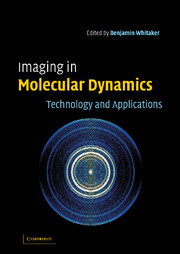Book contents
- Frontmatter
- Contents
- List of contributors
- Preface and acknowledgements
- List of abbreviations
- Part 1 Technology
- Part 2 Applications
- 8 Kinematically complete imaging of molecular many-body fragmentation: coincident multi-particle detection and analysis
- 9 Collisions of HCl with molecular colliders at ~ 540 cm-1 collision energy
- 10 Measurement of state-resolved differential cross-sections of bimolecular reactions using single beam velocity mapping
- 11 Slice imaging: a new approach to ion imaging and velocity mapping
- Index
9 - Collisions of HCl with molecular colliders at ~ 540 cm-1 collision energy
Published online by Cambridge University Press: 07 August 2009
- Frontmatter
- Contents
- List of contributors
- Preface and acknowledgements
- List of abbreviations
- Part 1 Technology
- Part 2 Applications
- 8 Kinematically complete imaging of molecular many-body fragmentation: coincident multi-particle detection and analysis
- 9 Collisions of HCl with molecular colliders at ~ 540 cm-1 collision energy
- 10 Measurement of state-resolved differential cross-sections of bimolecular reactions using single beam velocity mapping
- 11 Slice imaging: a new approach to ion imaging and velocity mapping
- Index
Summary
Introduction
The use of spectroscopic techniques to study crossed molecular beam scattering has been both fruitful and difficult to accomplish. The advantage of using laser spectroscopy to detect the products in crossed molecular beam scattering experiments is that one can obtain quantum-state-selective information about the scattering process. The disadvantage is that it is difficult to design an experiment with sufficient wavelength and spatial resolution and detection sensitivity. For this reason until quite recently laser induced fluorescence (LIF) was the only laser-based technique used for the quantum-state-selective detection of scattering products [1–5]. Recently the technique of ion imaging has been used to increase the sensitivity of ionization detection such that resonance-enhanced multi-photon ionization (REMPI) can now be used to detect molecular beam scattering products. Suits et al. were the first, in the early 1990s, to apply ion-imaging techniques to bimolecular scattering [6]. Since then, ion imaging has been found to be a powerful tool for the study of bimolecular inelastic scattering. Ion imaging has been used to measure differential cross-sections (DCSs) [6,7], as well as to measure collision-induced rotational alignment [8] and orientation [9]. In this chapter we will focus on a new application of ion imaging, the retrieving of correlated energy transfer distributions from crossed molecular beam ion imaging experiments.
The previous studies of bimolecular collision systems consisted of a diatomic target molecule colliding with a rare gas atom. The monatomic collider gas has no internal energy, and a single rotational state of the diatomic molecule was detected, using REMPI.
- Type
- Chapter
- Information
- Imaging in Molecular DynamicsTechnology and Applications, pp. 208 - 216Publisher: Cambridge University PressPrint publication year: 2003



